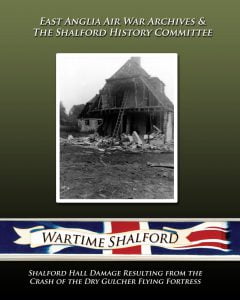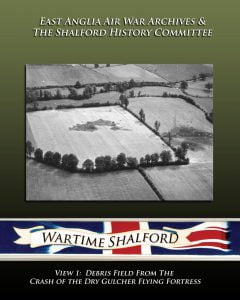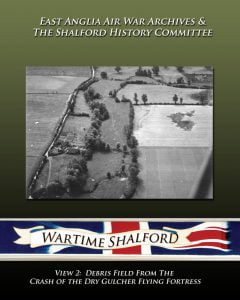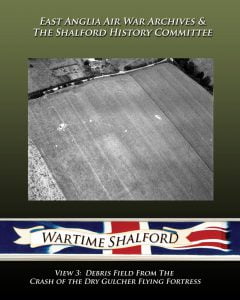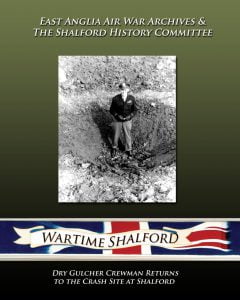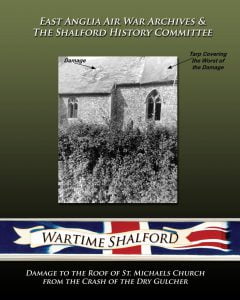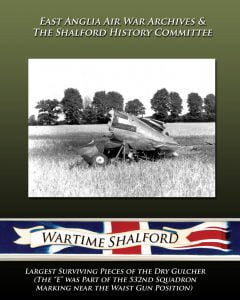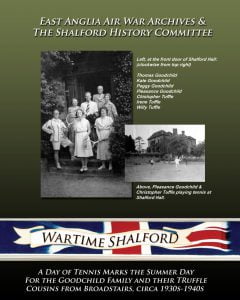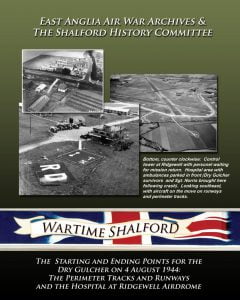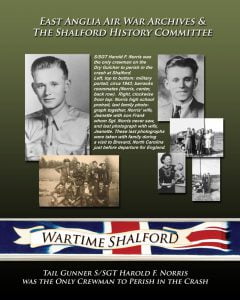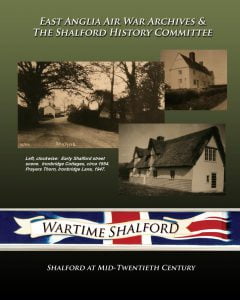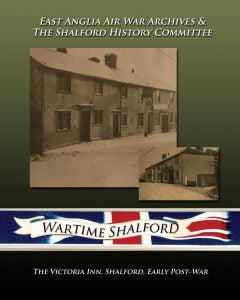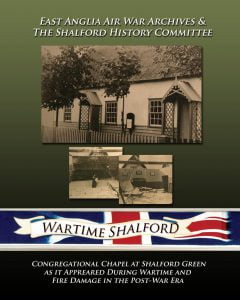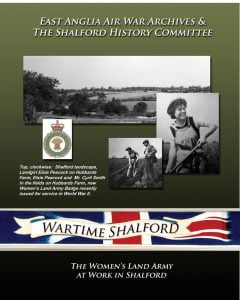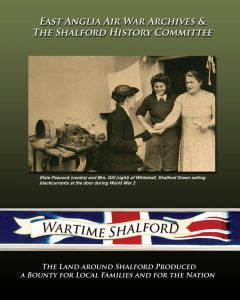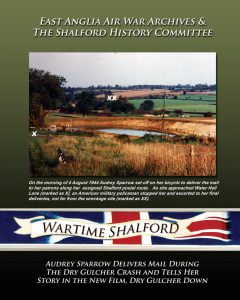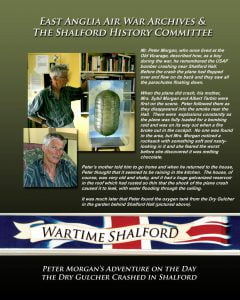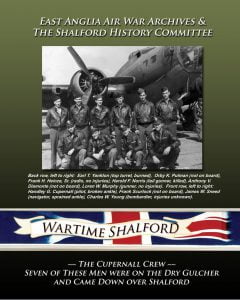
Help OPHF continue its mission by donating now. Your charitable contributions directly aid in our work and are completely tax deductible.
The East Anglia Air War Project page is divided into the following sections.
Click an item to jump directly to that section.










History of the Project
During World War II, the United States established air bases in East Anglia to support daylight bombing against the Axis powers in Europe. Throughout the region, small communities made way for the construction of large-scale airdromes. Farm land turned into a landscape of concrete, Nissan huts, and the implements of war as American bomber and fighter groups built significant infrastructure for operations against Nazi-held targets deep inside Europe. The sudden appearance of the Eighth Air Force in rural England, the rapid growth of the number of bases over a short time frame, and the resulting daily struggle for life and death over the skies of England and the continent forged a unique sense of community in these British villages and towns. For the American air crews and ground personnel and their British hosts, their common goals, together with the daily demonstration of sacrifice by the young air crews for Mother England and the Free World, shaped a special relationship between the embattled British people and their distant American cousins from “over the pond.”
Recent trends in the literature of military history have revealed that historians have broadened their approach to the study of military manoeuvre and contest to include much more than the operational realities of conflict. The New Military History, as it has come to be called, has added social history to the mix, providing a more diverse portrait of the human experience in war. New tools and sources add to the resources applied to the story of war and the men and women who were the actors in that drama. Oral history is one such tool that can bring diverse threads to the historical canvas: music, culture, language, food, religion, and a host of other elements that can play a role in the unfolding story. These stories of community, once considered new elements in the military narrative, have become a traditional component of the literary deposition laid down as the historical record. More than mere facts and figures of manoeuvre, tactics, or grand strategy, oral history often tells us more about the world in which the military drama played out.
As historians considered the social history in the military arena, oral history as a tool has grown in importance and frequency of use. Across the university landscape, oral history programs and centers have sprung up to support the new scholarship. Over the last quarter century technological advances have paved the way for oral history to grow as a sub-discipline and to develop as one tool among many for the historian. More recent and dramatic developments in digital technology have created other tools that perhaps need to be added to the military history arsenal. The East Anglia Air War Project (EAAWP), based at Abilene Christian University, Abilene, Texas, has expanded its study of Allied air operations and World War II England to include a full array of technology tools.










In 2002, the EAAWP was established with the goal to preserve the memory and history of community in wartime England, in particular the community established between the American airman who came in large numbers beginning in 1942 and the British families who lived in rural England near and around the American bomber and fighter bases. The project focuses on the agricultural areas north and northwest of London where large numbers of American air bases were established among the farming villages and towns that stretch from Norwich on the east to Kettering to the west of Cambridge. The target interview audience has been American aircrews and ground personnel stationed in the Eighth Air Force and British family members who were children or young adults during World War II. Since 2014 the Ninth Air Force bases and areas have been added to the study. The underlying oral history methodology continues to rely heavily on an archival research design and a literature review of a growing historiography of secondary works, memoirs, and regimental histories.
Historical archaeology proved to be an essential tool in developing historical data relating to life on the American air bases in East Anglia and in the surrounding villages. Today the historic sites are deteriorating, but much of the physical environment remaining offers clues to the history that played out there during World War II. Archaeological site surveys produced maps and photograph collections that revealed patterns of site use, structural relationships, and living styles that adds to wartime memory. The archaeological survey supported a varied investigation of the physical environment that addressed these four specific objectives:
- Collect data that will establish a sense of place and demonstrate how the built environment figured into community
- Examine and record structural relationships, construction descriptions, and building use.
- Determine the level of decay and residual evidence remaining that confirms archival and interview evidence.
- Create databases, still photography, and videography collections relating to the historic site.
These collections will support the oral history interviews associated with the events at that World War II venue.








The New Military History: Oral History, Collaterals, and Film in the Preservation of Memory and Community in World War II England
Recent trends in the literature of military history have revealed that historians have broadened their approach to the study of military manoeuvre and contest to include much more than the operational realities of conflict. The New Military History, as it has come to be called, has added social history to the mix, providing a more diverse portrait of the human experience in war. New tools and sources add to the resources applied to the story of war and the men and women who were the actors in that drama. Oral history is one such tool that can bring diverse threads to the historical canvas: music, culture, language, food, religion, and a host of other elements that can play a role in the unfolding story. These stories of community, once considered new elements in the military narrative, have become a traditional component of the literary deposition laid down as the historical record. More that mere facts and figures of manoeuvre, tactics, or grand strategy, oral history often tells us more about the world in which the military drama played out. As historians have considered the social history in the military arena, oral history as a tool has grown in importance and frequency of use. Across the university landscape, oral history programs and centers have sprung up to support the new scholarship. Over the last quarter century, technological advances have paved the way for oral history to grow as a sub-discipline and to develop as one tool among many for the historian. More recent and dramatic developments in digital technology have created other tools that perhaps need to be added to the military history arsenal. The East Anglia Air War Project, directed by Dr. Vernon L. Williams and based in the Old Primero Historical Foundation in Abilene, Texas, has expanded its study of Allied air operations and World War II England to include a full array of these technology tools.
In 2002, the EAAWP was established with the goal to preserve the memory and history of community in wartime England, in particular the community established between the American airman who came to the United Kingdom in large numbers beginning in 1942, and the British families who lived in rural England near and around the American bomber and fighter bases. The project focuses on the agricultural areas north of London where large numbers of American air bases were established among the farming villages and towns that stretch from Norwich on the East to Kettering to the West of Cambridge (see Figure 1). The target interview audience has been American aircrews and ground personnel in the Eighth and Ninth Air Forces and British family members who were children or young adults during World War II. The underlying oral history methodology has relied heavily on an archival research design and a literature review of a growing historiography of secondary works, memoirs, and regimental histories.
Using oral history strategies that included new digital tools and public history methodologies, the project has expanded opportunities for oral history, and the preservation of collateral collections to disseminate the historical record to a broader and more diverse audience. These collateral collections include photographs, diaries, letters and other materials held by the interviewee, as well as artifacts and data generated by archaeological surveys and investigations of air war sites and spaces.
Recent innovations in film and video technology have created new avenues of interpretation and preservation of the American air war experience in East Anglia. The collection of digital interviews, together with supporting collateral evidence, provides more comprehensive data from which to draw conclusions, establish interpretation, and produce historical products. In addition to recording the interview, the collaterals are assembled and placed into a collection associated with the interview. See the Fieldwork examples below and the Dry Gulcher slide show for examples of the collateral work done in conjunction with the oral history interviews.
Sample Clips of Oral History Interviews
Patricia Steegles, British School Girl
Jack A. Hayes, B-17 First Pilot
Paul “Bud” Haedike, B-17 Gunner
Ocassional Newsletters and News on the Work of the Old Primero Historical Foundation
2013 the East Anglia Air War Project published a newsletter to provide supporters and those who are interested in the work of the Project an update on progress for the first decade of work. In 2017 a second report appeared to reveal plans for the new Old Primero Historical Foundation and its support of the history of the air war in World War II. Click on the links below for a pdf copy of the two documents.
The pandemic has delayed the recent newsletters, but you can click on the Awards and Films tabs to view recent work completed and some new projects underway.
- 2019-2022 (coming soon)
- 2017-2018 Newsletter
- 2013 Newsletter
Field Work at Ridgewell




Since 2001 more than fifty oral interviews of 381st Bomb Group air and ground crews have been produced. In conjunction with the interview program, in summer 2002 the EAAWP conducted a historical site survey at Ridgewell using a team of eighteen university students and two historians. Using site maps of wartime Ridgewell, the team (see images below) produced a collection of materials that documented the following historical realities and opportunities for additional study:
- The survival status of structures from wartime Ridgewell to the present day.
- Produced a survey of major elements at Site 3 and Site 11, representing the largest remaining groups of buildings of any of the wartime sites at Ridgewell.
- Documented patterns of construction that provided essential data on the patterns of living and site use by individuals and by groups.
- Identified a disposal area where both military artifacts and personal refuse were found. No previous disturbances are evident so this site holds great promise for a future excavation.




The resulting data collection relating to the physical place at Ridgewell added essential evidence to the oral history collection. Further, the potential for future excavations at the newly-identified refuse dump at Ridgewell promised to yield a significant collection of artifacts, many of which relate to the living conditions for the Americans at Ridgewell. Figure 2 contains a sampling of surface artifacts collected at the proposed excavation site. Notice that the pictured artifacts include not only aircrafts parts, but also personal items such as a toothbrush and a shaving cream tube, all discarded at Ridgewell before 1945. These samples and the presense of a large scatter field on the site’s surface, suggests that a future excavation would yield a significant collection of physical evidence about life at Ridgewell during the war.


While archaeological operations at the related historic sites produce valuable data for the interview collection, steps are taken during the interview session to add to the collateral collection as well. During the years since the site survey, a large number of 381st Bomb Group interviews have been added to the oral history collection.
1st Air Division Surgeon Thurman Shuller's Wartime Diary Released in July 2021
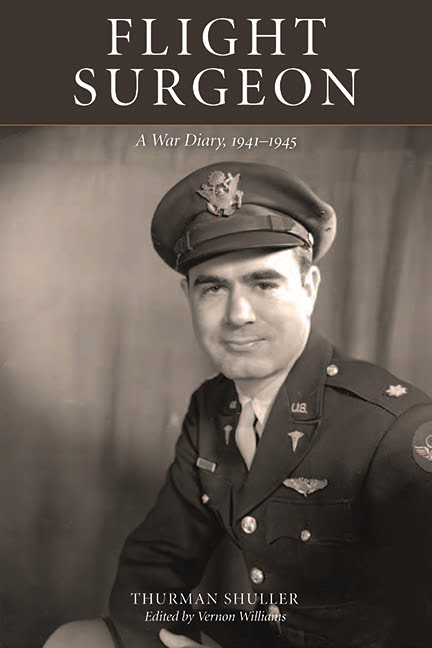

Colonel Thurman Shuller graduated from medical school in 1939, and after a two-year internship at Charity Hospital in New Orleans, he entered the Army with a commission as First Lieutenant in the Medical Corps. Shuller’s World War II diary begins two months after his arrival at Las Vegas Field to assume his position as a doctor in the newly constructed hospital at the Gunnery School. Shuller’s diary entries reveal the routine of army life that he faced, and his attitudes and concerns during his maturation and evolution as an Army combat surgeon during training and later in the combat theater of operations from his base at Thurleigh in Bedfordshire, England, first with the 306th Bomb Group and later, as Division Surgeon for the 1st Air Division at Brampton Grange in Huntingdonshire. The war diary covers six books that he wrote during the war that Dr. Vernon L. Williams, as editor, has organized into a book of seven chapters. The volume was published by Texas Christian University Press in July 2021 and is organized in the following fashion:
Table of Contents
Acknowledgments
Abbreviations Used in the Diary
Editor’s Note
Introduction
A Note from the Diary’s Author
Chapter 1, Prologue to War (September 5, 1941–July 31, 1942)
Chapter 2, A Doctor Goes to War (August 1, 1942–May 12, 1943)
Chapter 3, A Doctor at War (May 13, 1943–March 9, 1944)
Chapter 4, A Doctor in the ETO (March 10, 1944–December 30, 1944)
Chapter 5, Hostilities Cease (January 1, 1945–October 20, 1945)
Chapter 6, Farewell to England (October 21, 1945–December 9, 1945)
Epilogue
Endnotes
Appendix A: Thurman Shuller Chronology
Appendix B: Shuller’s Plea to Limit Missions
Appendix C: Shuller’s Arguments Against Maximum Effort Policy
Selected Bibliography
Index
About the Author and Editor
The Next Book is Coming Soon!
Crucible of War: The Anglo/American Exchange in World War II England, 1942-1945
- Chapter 1. Setting the Stage
- Chapter 2. Little America, A Sense of Place
- Chapter 3. The Red Cross and the Aero Clubs
- Chapter 4. Race: The Shifting Landscape
- Chapter 5. The Moral Dilemma
- Chapter 6. Glamour and Hollywood
- Chapter 7. The Moral Dilemma
- Chapter 8. War Brides
- Chapter 9. Bonds that are Never Broken
- Chapter 10. Epilogue
- Setting the Stage–This chapter will introduce the war in England beginning in September 1939 and explore early American involvement in strategic planning, preparations for the air war and later military operations against Germany, and the emerging construction strategy that will grow into a massive American presence in rural England.
- Little America, A Sense of Place—Chapter 2 will examine the built environment that developed in East Anglia and west across the Midlands and how the war established a sense of place in the villages and towns across England. Emphasis will be made on the nature of life and work on newly-built airfields across East Anglia and how life changed for both the Yanks and the British families in the villages and towns in these rural communities. This chapter will examine the architectural footprint that emerged almost overnight during the war and how airfield construction produced large numbers of new buildings juxtaposed within local villages that had remained unchanged for generations. The war became a watershed that led to changes in village life in many of the rural areas.
For many Americans, East Anglia and the villages and towns across rural England became a refuge from the stress and terror that air crews encountered in the air war against Germany. Airmen who flew missions against dangerous targets and survived the battles in the skies across occupied Europe, returned to their base and the villages nearby. These villages and the British families who lived there provided a temporary respite from combat. As the war wore on, a sense of home developed in the comfortable cottages around the base and in the local pubs, together with passes to London, weekly dances, church fetes, and in other routines that mediated that rigors of war. The lingering airfield ruins that remain after over three-quarters of a century after the war continues on as a marker in the corporate memory for British families today. - The Red Cross and the Aero Clubs—As the large numbers of airfields began to appear across East Anglia, American Red Cross officials organized Red Cross clubs and clubmobile operations at airfields where bomber and fighter groups had recently arrived to begin air operations against occupied Europe. Club directors and other assistants arrived at airfields with orders to establish Aero Clubs using Nissen huts or other buildings commanders provided for this purpose. The Red Cross staff hired local villagers for the club workforce, organized local British volunteers to help with the various club programs, and established libraries, game rooms, snack bars, and mobile canteens called clubmobiles. The aero clubs established a schedule of events that included weekly dances, parties, and other activities and provided a place where airmen could find recreation and escape that provided a little touch of home to the war environment.
- Race and the Shifting Landscape—This chapter will explore the introduction of large numbers of African-American troops into the largely all-white British rural community, the cross-cultural interchange, the arrival of large numbers of all-white American military units, and the resulting racial conflict that developed across England.
- Big Bands and the Jitterbug—During World War II, a new American-style of music made its appearance in England, dominating the Anglo-American cultural exchange that reached dramatic proportions after 1942. American big band music, coupled with the jitterbug dance craze, swept the British Isles by storm during the war years. Glenn Miller’s arrival in England with his new Army Air Corps Band in 1944 triggered a new blitz for the British—this one much more pleasant than the German one. Reaching out into the rural heartland, Miller’s band played over eight hundred concerts, recorded at Abbey Road Studios, and aired live concerts on the BBC from the Corn Exchange in Bedford. The resulting invasion of the new band music and the dance craze signaled a new optimism in wartime Britain, lifted up morale for both the Americans and the British across war-weary England, and provided a platform for a growing cross-cultural exchange as the American presence grew to a staggering level in the last years of the war. The wartime musical trends lasted well into the 1950s when a new revolutionary musical style exploded upon the scene—rock n’ roll.
- Glamour and Hollywood Come Calling—World War II represented an enormous increase in the role the USO and the entertainment industry on the American military experience. This growing USO presence coincided with the buildup of American military forces in England during the lead up to the Normandy invasion in June 1944. While the USO was so engaged in every theater of war across the globe, entertainment and motion picture stars came to England in a steady and increasing number. Led by Bob Hope and Bing Crosby, movie stars and other celebrities flooded into England to put on shows at airfields and military bases everywhere. With the box office stars of Hollywood, the USO also brought a host of other performers to England, vaudeville entertainers, singers, musicians, and dancers. Many were well-known personalities and many other artists were not household names but yearned to do their part. This chapter will explore the impact that the USO had on morale and the wellbeing of service men and their British neighbors during the war.
- The Moral Dilemma—With the arrival of large numbers of American military personnel throughout England, problems developed that strained the social framework in British society. Promiscuity, sexually transmitted diseases, unwed mothers, threats to the institution of marriage, and the confusion to standards of morality—all contributed to a growing sense of crisis in a society suffering from threats from many fronts.
- War Brides—For many British families, the arrival of the Americans in England signaled more than a momentary cultural exchange, it produced dramatic changes, upheaval, struggle, loss and for many, a victory of sorts. My interest in the war bride story produced a series of oral interviews that disclosed much more than the tale of the young British wives and their new lives in the United States. These narratives revealed much about the lives of British families, the impact of the European war on family life, and the cultural collision that took place as an American soldier entered the family structure and threatened the status quo. Marriage to an American meant a goodbye and separation that for many proved permanent and forever. This chapter will examine these social realities and the cultural exchange that they produced.
- Bonds that are Never Broken—Chapter 9 will investigate the relationships developed during the war and how those relationships have fared over the years since 1945. Has the sense of community in wartime England survived? Is there a significant bond between the people of England and the Americans that is based on the wartime experience? How does succeeding generations of British family members view the Americans and the wartime experience? How was the war brought home to the British villagers? How does memory add to the historical perspective in British minds?
- Epilogue
Field Work at Wethersfield ~ University Field Team to England in June 2016


The four images below picture Wethersfield during wartime.








The images below depict the university student team and Dr. Williams in various towns in County Essex presenting programs on World War II England.






These images below are documentary photographs of wartime buildings at the 416th Bomb Group base at Wethersfield as they appeared in 2016, 71 years after the close of World War II.
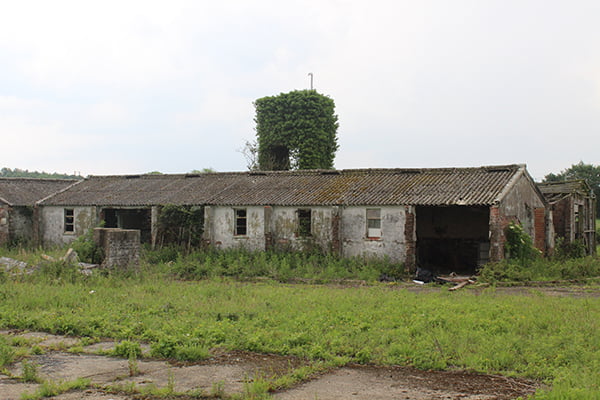

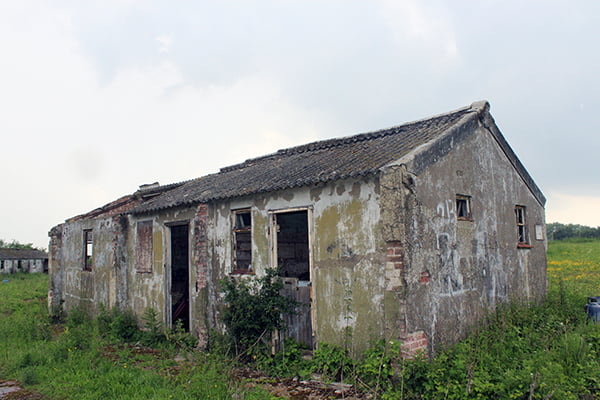



The Field School team visited the Cambridge American Cemetery to create a series of documentary photographs of the graves and structures built to honor those who were buried here during World War II. The team gathered with Dr. Williams at the grave of Williams’ uncle, S/Sgt Harold F. Norris, who perished in a firey crash of his plane just three miles from Wethersfield on August 4, 1944.
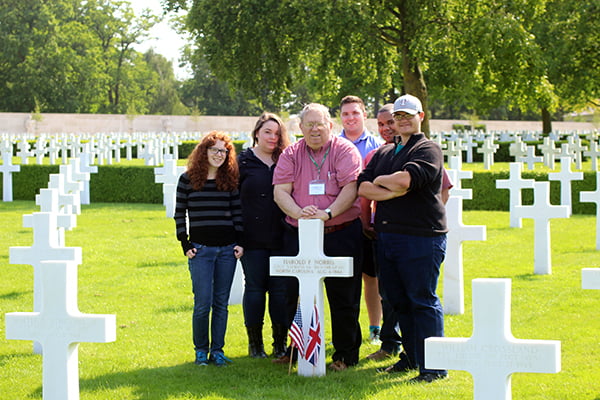



The following selected exhibit panels were produced are part of a 30-panel exhibition gifted to Shalford village in 2008. They contain a few images from the wartime history of Shalford.
Dry Gulcher Slideshow (Click on a panel to view a larger image)
Click on any image to expand to full size.
Visit Old Segundo Productions for purchase of documentary films and books or view details about forthcoming films on American history topics. All proceeds benefit the East Anglia Air War Project.







